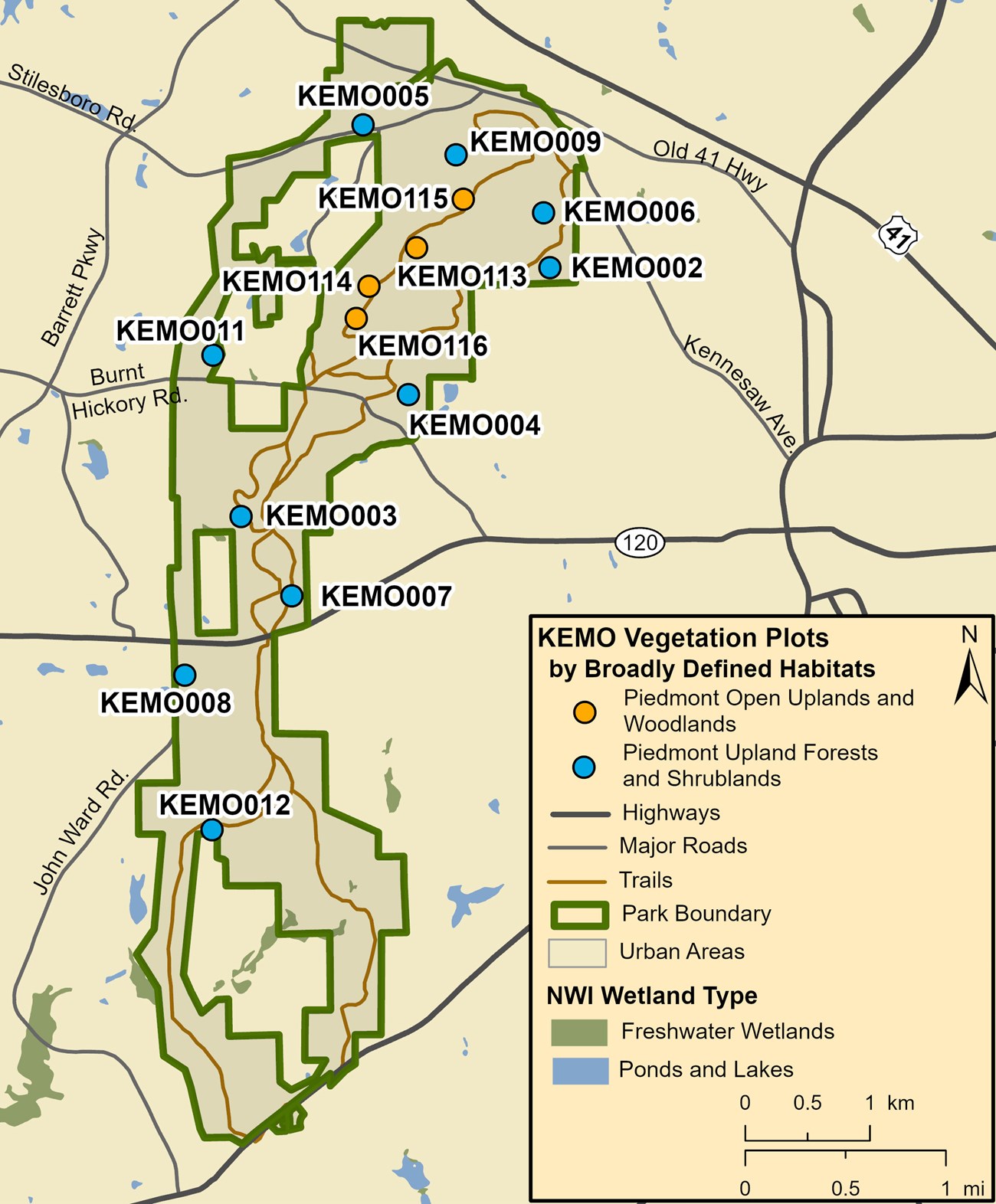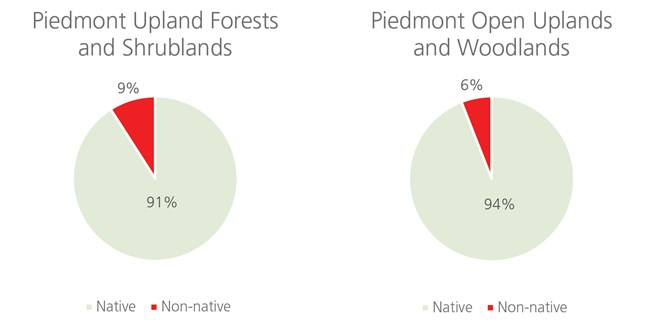Last updated: May 21, 2024
Article
Terrestrial Vegetation Monitoring 2021 Data Summary for Kennesaw Mountain NBP

Overview
Vegetation communities are dynamic entities influenced by environmental factors and impacts from natural and anthropogenic disturbances. The diversity of plants within the southeastern Coastal Plain contributes to a range of ecological services, provides habitat and resources to an array of wildlife, and functions as nature’s backdrop—usually the primary visual cue pulling us toward an appreciation of the outdoors. Determining trends in vegetation communities over time and identifying plant stressors is therefore vital to understanding the ecological health of terrestrial ecosystems within Southeast Coast Network (SECN) parks. Collectively, this information can be used to guide management actions that sustain a park’s ecological integrity and support plant conservation across a diversity of spatial scales for generations to come.
Methods
The Southeast Coast Network collects long-term data on terrestrial vegetation within its parks using a peer-reviewed protocol similar to other NPS Inventory and Monitoring networks in the eastern U.S. and is modeled after the approach used to describe natural vegetation in the Southeast developed by the Carolina Vegetation Survey. Permanent plots are used as the sample unit to determine a site’s (1) vascular plant richness and abundance for all native and non-native species; (2) basal area, density and health for all woody species; (3) density of forest floor fuels; (4) community level disturbance events, including presence of insect pests and disease; and (5) abiotic condition (e.g., landform shape, soil nutrients, canopy coverage and height). Plots are randomly located across broadly defined habitat types within SECN parks. Our sampling effort focuses on dominant (> 30% coverage) habitat types within these parks, but when time and resources allow, the sampling effort is increased to include less dominant types. The 2019 Terrestrial Vegetation Monitoring Protocol provides detailed descriptions of field and data processing techniques used by the Southeast Coast Network.
Study Area
Kennesaw Mountain National Battlefield Park (NBP) is a 1,183-hectare (2,923-acre) urban park in Cobb County, Georgia, roughly 32 kilometers (20 miles) northwest of Atlanta. It is the second-most visited national battlefield in the United States, drawing close to 1.5 million visitors a year. As the first designated Globally Important Bird Area within Georgia, the park serves as a focal area for bird conservation within the southeastern Piedmont. The park is dominated by a mixture of early-to mid-successional upland pine, oak, and mixed hardwood forests. There are also forested- and graminoid-dominated wetlands along Noses Creek and the park’s other small streams. The upper elevations of Kennesaw and Little Kennesaw Mountains are a mosaic of open vegetation types occurring under a stunted canopy of widely-spaced trees. These intermixed glades and woodlands are on thin, rocky soil adjacent to open rock. Within the park, these thin soils are underlain by a combination of felsic (e.g., granite gneiss) and mafic (e.g., amphibolite) geologic material, yielding a unique combination of vegetation with affinities to both acidic and basic soils. This protocol was implemented for the first time at Kennesaw Mountain NBP in 2021, and these data represent the baseline status of vegetation and associated abiotic elements from the following broadly defined habitats of the park: Piedmont Open Uplands and Woodlands and Piedmont Upland Forests and Shrublands. Fourteen plots were established across these habitats (see map).

Significant Findings
Site and Environmental Factors
Kennesaw Mountain NBP lies within the Southern Inner Piedmont ecoregion of Georgia. The Southern Inner Piedmont typically has higher elevations and steeper slopes than the rest of the Piedmont, with gneiss and schist rocks yielding nutrient-poor, acidic soil. Like most of the landscape across the southeastern Piedmont, the land that occupies the park has been subjected to profound impacts by humans following European settlement, including conversion of native forests to agriculture and timber land. Within the past century, profound increases in urban development around the park has had an additional impact on its forested resources. Urbanization is likely an important factor in contributing to non-native, invasive species spread in the park, and also serves as a deterrent for the use of fire to restore ecological processes. High densities of white-tailed deer (Odocoileus virginianus) are found within Cobb County, Georgia. Heavy deer browse indicators were found across the Kennesaw Mountain National Battlefield Park’s forested uplands during this monitoring effort.
Vegetation
One hundred and eighty-four plant species were observed across all plots, including 27 taxa not detected in previous plant surveys. Overall plot level plant richness ranged from 44 to 63 species within Open Upland and Woodland habitat and 27 to 56 species within Upland Forest and Shrubland habitat. Diversity was highest in the herbaceous stratum of open uplands, and highest in the tree stratum of upland forests.

Non-native species were frequent across all plots and broadly defined habitats surveyed during this monitoring effort, including 14 species ranked as invasive by the Georgia Exotic Pest Plant Council. Chinese privet (Ligustrum sinense)—a Category 1 invasive—dominated the seedling stratum of Open Upland plots within the park. Other invasives that were frequent within monitoring plots included Japanese honeysuckle (Lonicera japonica) and Japanese stiltgrass (Microstegium vinimeum).
Other Findings
- Two species of special concern listed for Georgia by the Georgia Department of Natural Resources were observed within Open Upland plots during monitoring: green, or Missouri, rock cress (Boechera missouriensis) and Stone Mountain mint (Pycnanthemum curvipes).
- Of the 13 tree-sized white ash (Fraxinus biltmoreana) measured during monitoring, two were dead and four were experiencing unhealthy vigor. Although the emerald ash borer (Agrilus planipennis), a serious insect pest decimating ash trees throughout the eastern and midwestern United States, has been detected in Cobb County, Georgia, it is not certain whether the declining health of ash observed within these monitoring plots is due to the insect pest, or edaphic factors responsible for natural mortality and decline, or other factors.
- All plots are scheduled to be resampled in spring/summer 2025.
Full Report
The full report for Terrestrial Vegetation Monitoring at Kennesaw Mountain National Battlefield Park 2021 Data Summary
About the Southeast Coast Network
In 1999, the National Park Service initiated a long-term ecological monitoring program, known as “Vital Signs Monitoring,” to provide the minimum infrastructure to allow more than 270 national park system units to identify and implement long-term monitoring of their highest-priority measurements of resource condition. The overarching purpose of natural resource monitoring in parks is to develop scientifically sound information on the current status and long-term trends in the composition, structure, and function of park ecosystems, and to determine how well current management practices are sustaining those ecosystems.
The NPS Vital Signs Monitoring Program addresses five goals for all parks with significant natural resources:
- Determine the status and trends in selected indicators of the condition of park ecosystem,
- Provide early warning of abnormal conditions,
- Provide data to better understand the dynamic nature and condition of park ecosystems,
- Provide data to meet certain legal and Congressional mandates, and
- Provide a means of measuring progress towards performance goals.
The Southeast Coast Network (SECN) includes eighteen administrative areas containing twenty park units, fifteen of which contain significant and diverse natural resources. In total, SECN parks encompass more than 184,000 acres of federally-managed land across North Carolina, South Carolina, Georgia, Alabama, and Florida. The parks span a wide diversity of cultural missions, including four national seashores, two national historic sites, two national memorials, six national monuments, two national military parks, as well as a national recreation area, national battlefield, national historical park, and an ecological and historic preserve. The parks range in size from slightly more than 20 to nearly 60,000 acres, and when considered with non-federal lands jointly managed with the National Park Service, the network encompasses more than 253,000 acres.
For More Information
SECN Home Page
(https://www.nps.gov/im/secn/index.htm)
SECN Reports and Publications
(https://www.nps.gov/im/secn/reports-publications.htm)
NPS Inventory and Monitoring Program
(https://www.nps.gov/im/index.htm)
Data Downloads via the Natural Resource Information Portal
(https://irma.nps.gov/portal/)
